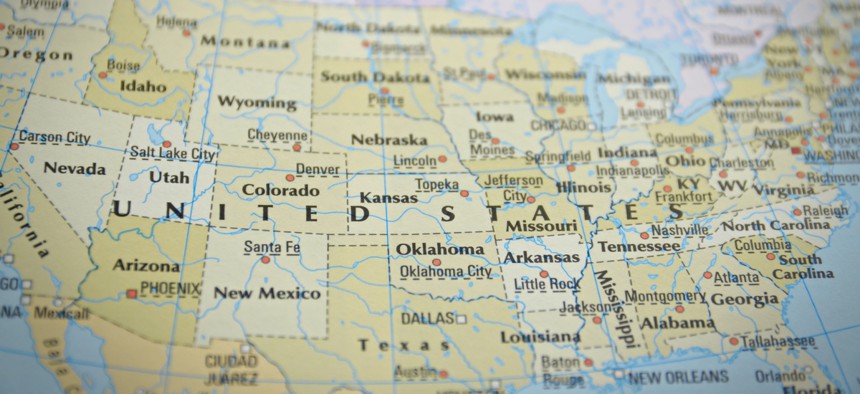Census Officials Say They’re Ready, With or Without Citizenship Question

Robert_Chlopas/Shutterstock.com
A year out, preparations are on track to allow responses online, by phone or on paper.
Regardless of whether the Supreme Court this spring allows the Trump administration to add its controversial citizenship question, planners of the 2020 decennial count expect to keep to their schedule, Census Bureau officials said on Monday.
“July 1 is the printing date, and the court is aware of our need to have a response by that date,” Albert Fontenot Jr., associate director for decennial census programs, told reporters covering the bureau’s “one-year-out kickoff event” at the National Press Club.
“Final preparations are made for either decision—run Form A or run Form B. It won’t delay our plan at all,” Fontenot said. The electronic option available to census respondents, he added, will be adjusted for including or omitting the question critics fear will depress the response rate among noncitizens.
A test run is already underway with questionnaires being sent to 480,000 people, half with and half without the citizenship question. “If we see a strong variation, we will use that to plan our staffing requirements,” Fontenot said.
Top bureau officials spoke after a spirited rollout of information about the year of activity leading up to Census Day 2020. Using the slogan “Shape Your Future: Start Here,” the coming count will be the first to allow respondents a choice of participating online, by phone or on paper.
The bureau is “on mission, on schedule, on budget, on message, and on course to complete the biggest and best census ever,” said Steven Dillingham, the bureau’s 25th director. He pointed to better technology, more language assistance and more customer assistance phone centers for targeting hard-to-reach populations, along with new technology to safeguard data.
The results of the census will help decide how $675 billion in annual federal dollars is spent on schools, social services, infrastructure, public safety and business competitiveness, he said.
Set to testify to Congress on Tuesday, officials were firm under questioning that their current budget is sufficient. “We have strong bipartisan support at all levels of government,” Dillingham said.
The latest testing milestone—a 50-state data prototype exercise based in Providence, R.I., last August—showed that “all of our systems deployed effectively, in real-world conditions,” Fontenot said. The productivity rate of the most-desired self-responses (without follow-up prodding) was 52.3 percent, up 3 percent over the 2010 exercise “without a motivational advertising campaign,” he added. “2020 will have the strongest advertising campaign in census history,” heavily reliant on social media.
“Internet responses are quicker and easier for us, but we recognize that not everyone has access to the Internet,” Fontenot said. Special efforts are being made to target people living in university dorms, prisons, and out on the street, as well as “highly mobile” people living in “RVs, hotels, racetracks, circuses and carnivals,” he said.
The bureau, as of Monday, has 37 of 39 hiring offices ready for taking on and training what will be 500,000 temporary employees. Last fall, the bureau received 200,000 applications for 50,000 jobs, said Timothy Olson, director of field operations—more than two months ahead of schedule.
For the first time, the bureau is recruiting the temporary census workers online, Olson said. He is “cautiously optimistic” that, with help from 1,500 partner groups and 300,000 organizations, they can attract 2.3 million applicants by this fall for enumerators, some of whom will be bilingual. Hourly wages will be $13.50 to $30, depending on region, with a mileage reimbursement.
The bureau has opened six regional centers, staffed separately with 600 employees, in the same cities as their ongoing regional offices. Mailout of questionnaire kits is being done by the Census center in Jeffersonville, Ind., also the location of the bureau’s eastern return processing center, with the western processing center located in Phoenix.
Also speaking at the rollout event were representatives from key census partner organizations. Bill Anoatubby, governor of the Chickasaw Nation, noted that American Indians are the most undercounted population, with an undercount of 4.9 percent estimated, due to “logistical obstacles such as no street names” in hard-to-reach census tracts, he said. He expects social media to improve things, and Census official Olson said consultation with tribes for the 2020 round began two years early.
Loida Garcia-Febo, president of the American Library Association, said the 6,000 libraries that host sites are crucial to people who want to respond online but lack an Internet connection. “Ninety-nine percent of the hard-to-count people are located within five miles of a public library,” she said.
Another undercounted group is children, noted Lisa Hamilton, president and CEO of the Annie E. Casey Foundation. “The 2010 Census missed 2 million children under five, particularly children of color,” she said. “We need a child-centered individual on every complete count committee.”
NEXT STORY: FCW Insider: April 2






